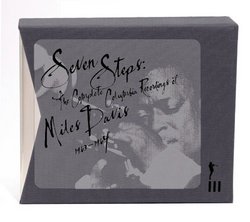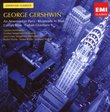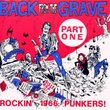| All Artists: Miles Davis Title: Seven Steps: The Complete Columbia Recordings of Miles Davis 1963-1964 Members Wishing: 3 Total Copies: 0 Label: Sony Release Date: 9/28/2004 Album Type: Box set, Limited Edition, Original recording remastered Genres: Jazz, Pop Style: Bebop Number of Discs: 7 SwapaCD Credits: 7 UPCs: 827969084021, 5099709084027 |
Search - Miles Davis :: Seven Steps: The Complete Columbia Recordings of Miles Davis 1963-1964
 | Miles Davis Seven Steps: The Complete Columbia Recordings of Miles Davis 1963-1964 Genres: Jazz, Pop
The seven CDs of Seven Steps chronicle the formative period of Davis's "Second Great Quintet" from its first arrival, bassist Ron Carter in the spring of 1963, to its last, tenor saxophonist Wayne Shorter in the fall of 19... more » |
Larger Image |
CD DetailsSynopsis
Amazon.com The seven CDs of Seven Steps chronicle the formative period of Davis's "Second Great Quintet" from its first arrival, bassist Ron Carter in the spring of 1963, to its last, tenor saxophonist Wayne Shorter in the fall of 1964. The set begins with the West Coast studio session for the Seven Steps to Heaven LP, with Miles, Carter, and tenor saxophonist George Coleman joined by L.A. musicians Victor Feldman (piano) and Frank Butler (drums). Then it's off to New York where Miles would cover the same material with Herbie Hancock in the piano chair and Tony Williams on drums. (The original LP selected tracks from each group, but all the tracks from both sessions are here, including unissued alternate takes.) The rest of the set features concert performances in which the band plays established Davis anthems along with a few choice standards. The leader is inspired throughout, lashing out with passion and urgency on trumpet that's clearly fuelled by the young and extraordinary rhythm section bubbling underneath him--Hancock shows an uncanny ability to shape a group's performance on a number of levels, balanced by the steady Carter and the incendiary Williams, whose drumming is both polyrhythmic and consistently, freely lyrical. In some ways, the set is a search for the right tenor saxophonist, but all are contenders. The polished Coleman constructs solos with remarkable tension curves. Sam Rivers is a startling presence, pressing the envelope with pin-wheeling runs and an assortment of accelerated bleats that highlight the rhythm section's avant-garde sympathies. However, the arrival of Shorter is unquestionably the highpoint, as the group dialogue developed by Davis and the rhythm section finally meets its perfect complement in Shorter's complex, multi-dimensional playing. As with Columbia's previous Davis sets, Seven Steps is another triumph of design, sound, and documentation. --Stuart Broomer Similar CDs
|
CD ReviewsSome Great Music & Some More Music Scott McFarland | Manassas, VA United States | 09/30/2004 (4 out of 5 stars) "When they first announced this box's concept years ago, it sounded like it was a bit less cohesive or purposeful than the others. And in fact it is. That's not to say that if you have the money in your pocket you shouldn't buy this. I would say though that if you don't have the money in your pocket, you're just fine on this one to buy it in pieces later. Disc 1 and the first part of Disc 2 contain the tracks from the two bands/sessions that constitute the "Seven Steps to Heaven" LP. The Los Angeles band/music is generally moody and very much focused on Miles' trumpet; the New York band is more inventive and active behind Miles. The music as mastered here is crystal clear. The alternate takes which exist are nice to hear but don't really teach us very much. This has been, and remains, a good album that represents a unique year in Miles' career. Discs 2 and 3 contain the Antibes concert formerly released as "In Europe", now augmented with a "Bye Bye Blackbird" we'd not been able to hear previously. The sound is mono but it's quite presentable. The band swings their hardest on this concert, and it's a nice 90 minutes' worth of music that any Miles Davis fan will enjoy. Discs 4 and 5 contain the famous NAACP benefit show from 1964 that resulted in 2 LPs worth of material, here for the first time put back into playing sequence and containing (a very nice version of) "Autumn Leaves". No Miles fan will want to be without this show as it is well-recorded, played with intensity, and contains definitive versions of a few tracks. This will inevitably be available as a 2-CD set and will be required listening for jazz heads. Discs 6 and 7, though, are by no means must-hear. Disc 6 has Sam Rivers playing sax with the band in Tokyo, replacing George Coleman who played well on Discs 1 - 5; it's the same repetoire that we've been listening to, nothing new here. Miles is the centerpiece and he plays much as he did in 1961 (now well-documented) and on though 1964. Disc 7 has Wayne Shorter finally into the band, but it's the same tunes we've been hearing and again not startling in any way. " Missing Link Collection Steven Kosakowski | West Coast Jazz | 10/02/2004 (4 out of 5 stars) "This terrific 7-disc set bridges the gap between the two great Miles Davis Quintet boxed collections already available from Columbia - the earlier featuring John Coltrane ('55-'60), and the later '60's version with Wayne Shorter ('65-'68). This 'Seven Steps' box collects Columbia recordings from 1963 and 1964, when all the slots in the later Quintet had been settled but that of the sax chair. So here we have Miles and his rhythm section - Ron Carter on bass, Tony Williams on drums, and Herbie Hancock on piano (except for one studio set with Victor Feldman) - joined by a succession of sax players, ending up with a live disc with Wayne Shorter finally aboard. Only one studio album represented here - most of the LA and New York sessions of April and May '63 were released as 'Seven Steps to Heaven', with one track showing up on the 'Quiet Nights' LP. (The remainder of 'Quiet Nights', by the way, is thoroughly covered on the Miles Davis/Gil Evans box set.) The rest of the box collects the live releases of the period, including notably the Antibes show, and the NYC Philharmonic concert of '64 formerly available in part on 'My Funny Valentine' and 'Four and More'. Here that show appears complete and in sequence across discs 4 and 5. There are still a few early '60's Miles-on-Columbia odds 'n' ends not yet swept up into one of these Quintet boxes, but all are readily available in recent remastered editions. To get the full sweep you'll still need the 'Someday My Prince Will Come' disc, the 'Complete Friday and Saturday Nights at the Blackhawk' box, the 2-disc 'Complete Carnegie Hall Concert' set, and the magisterial 'Plugged Nickel' box. And if the Columbia sets still aren't enough, there's a nice box from Dragon covering the Stockholm shows of 1960, some with Coltrane, some with Sonny Stitt. 3+ stars for the music here (relative to the phenomenal Miles Davis Quintets before and after, of course); 5 for the remastering, the physical presentation (box set as artifact), and above all for making available this historical chronicle of a period in the always fascinating musical history of Miles on Columbia." The "Forgotten" period of Miles Davis R. Lipman | SE Coast | 10/26/2004 (4 out of 5 stars) "This box set covers the period between the 2 great quintets of Miles Davis. The time in question is several years after the Coltrane band disbanded, but right before the great Shorter/Hancock years of the 2nd quintet.
Many have considered this time frame to be the equivalent of lost years or as time best to be forgotten. I am not one of those people. This is a band and a musician in transition. The established repetoire that forms the backbone of this set continiously evolves as Miles responds to the influence of new players. It is interesting to listen to the results of Miles' evolving thought processes. Certainly not all of it works and not all of the sidemen are up to the task, but taken as a whole there is very little not to like. This box set consists of the studio album "Seven Steps to Heaven" and a series of live concerts. The most well known of the live dates are "My Funny Valentine" and "4 and More" which were recorded on successive dates in early 1964 and released as 2 albums. The occasion was a series of concerts held a Lincoln Center in NYC to benefit the United Negro College Fund. Miles was comitted to this cause and by the time of the concerts, his working band had reached a relative level of comfort and maturity. Miles' comitment to the music and the band's comfort level are audible in that these tracks are standout sessions, that are reasonably well recorded. At times the interplay is sparkling as the players dance and weave sonically around each other. "Miles in Europe" captures the band in the middle of a European tour. To my ears, this is a good but not earthshattering session. The remainder of the live titles find Miles and company in Berlin and Tokyo. The Berlin tracks are a pleasant surprise as the original release did not have the best of sonics. The Tokyo dates consist of the usual repetoire, this time with Sam Rivers replacing George Coleman. For the Miles fan or completest, this set is a must buy. To the casual fan, maybe not. Sonically, this is a good sounding CD box set. Previous errors have been cleaned up (cf Miles in Berlin) and it sounds like the producer went back to the original master tapes to create the digital conversions. You will hear much better bass and treble extension, with nice silent backrounds- all a hallmark of good CD reproduction. What you will not hear is the additional air and ambience that is evident on the original vinyl pressings. The vinyl copies of the "4 and More" and "My Funny Valentine" pocess a holographic quality that at times is downright spooky. With the right equipment, you are back in early 1964. You do not get that feeling with this CD set. If you do not have the vinyl or if you have later "Nice Price" reissues, then this remaster is sonically better. If you have the original vinyl then you know what I mean. However, the disc that comprises "Miles in Berlin" is definately better than the orignal vinyl. Much more clarity, better frequency extension and a more realistic soundstage make for a much more enjoyable performance. "Seven Steps to Heaven" is comprised of material recorded in Ca and NYC. The CA material has a drier, sharper sound compared to the NYC material. Then again the NYC studio was very familiar to Miles and perhaps he felt more comfortable there ? If you are looking for a Xmass present to indulge yourself with or if someone in your life wants to get you a nice gift, look no further than this set. If you would like to further explore the so called "Forgotten Years" I would suggest "Friday and Saturday Night at the Blackhawk" This recording was made several years before the "Seven Steps" box, but again captures the sound of Miles in transition. Taken together you have an excellent period snapshot of Miles circa 1961-64. Recommended." |

 Track Listings (6) - Disc #1
Track Listings (6) - Disc #1


